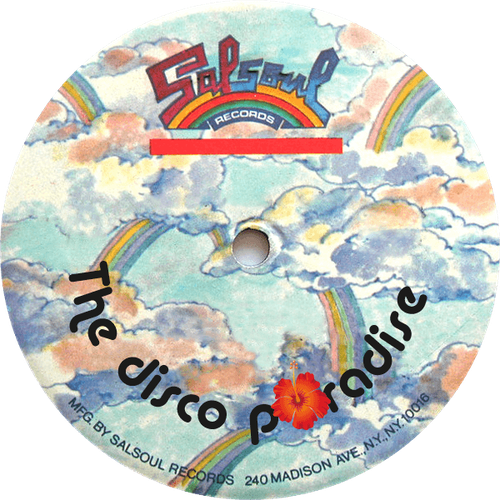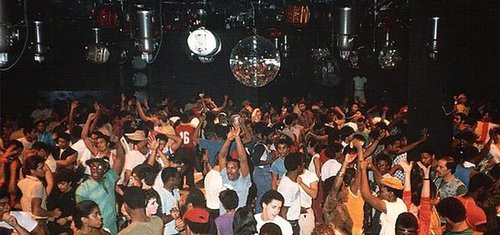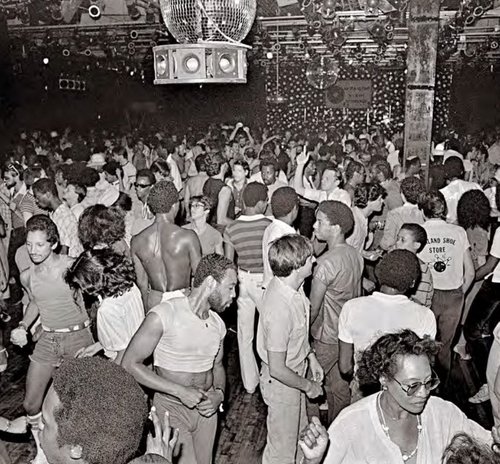What comes to your mind when you think of disco?
Many people think of John Travolta, platform shoes, disco balls, drugs, and sweaty dancing. But it is so much more than that. Disco is one of the most influential and important musical movements in the history of the world.
Disco was created by communities who were denied a voice. The Black, Latinx, and LGBTQ+ communities made themselves heard and created safe spaces in the form of discotheques, where they could peacefully express themselves. People of all identities, colors and ethnicities were able to be themselves without judgment in these early discos. This sentiment of freedom went global as disco took over the world, but as it passed through the hands of different artists with different experiences, disco began to change. The genre was becoming detached from the original stories and experiences of the people that began the movement. This pattern continued through the mainstream success, death, and revival of disco. The truth is that disco was created and innovated by Black, Latinx and LGBTQ+ people, and though the mainstream continuously fights to hide the artistic influence that these communities of people had on the genre and music in general, that does not mean the influence is not there. Without these communities, disco and the many cultural and musical innovations inspired by it would not exist.
The origins of disco don’t stem from any one specific place or time; rather, it is a blend of cultures, styles, and genres. R&B, soul, blues, gospel, and funk all were direct inspirations for disco. The late 60s and early 70s marked a time where innovations within those sounds set the foundation for disco. Distinct styles arose in different cities. The Philadelphia sound innovatively incorporated orchestral arrangements for their songs, as shown by the wonderful self-titled album by The Delfonics, released on Philly Groove Records. The Motown sound in Los Angeles set the ground for long, precise, and danceable songs, perfectly exemplified by Rick James’ Street Songs. Psychedelic soul created new sounds that changed the texture of past soul records with more emphasized electronic implementations; Funkadelic’s Free Your Mind… and Your Ass Will Follow is a great example of this. Latin percussion was also often used in disco, which brought on a salsa feel to many songs. Elements of Puerto Rican culture were very much present in many records, as dance is a prominent part of Puerto Rican culture. New York label Salsoul Records emphasized this blend of Latin and Black sounds—clear by its music and name. The label’s house band, Salsoul Orchestra, backed many artists on their label and succeeded as their own disco group as well.

These musical changes came about during the 60s, a time of great global change. The fight for civil rights was fervent, the youth were radicalized by the Vietnam War, and people were creating social revolutions whose results we still feel today. However, the following era of the 70s was not a time of prosperity. Violence, economic struggles, and corruption filled people with fear and mistrust in authority. Disco arose as a reaction to these negative emotions; it provided an escape for the people who were suffering the most in those times.
The Loft, created by David Mancuso in his New York home, was one of the first “disco” clubs and was imperative in the development of disco, conceptually and musically. With rampant homophobia and transphobia along with the criminalization of gay sex, bars within the community were often raided by the police. In the early 70s, however, discotheques arose as safe havens for the LGBTQ+ community. These discotheques facilitated a more open-minded environment which led to the acceptance of different experiences and expressions of sexuality. The mission of The Loft was mirrored by later discotheques like Paradise Garage, for instance. It was an invite-only club and it did not serve alcohol, making the point of the club to simply revel in your own individuality. Disco was used as a way to let people know that they were safe and able to be who they are, free from judgment. The perspectives of the LGBTQ+ community, people of color and women were more accepted in these discotheques.
These cultural changes were important to gender expression, as shown by the huge influence drag culture had on disco. Artists like Grace Jones and Prince challenged gender norms by embracing styles that blurred the lines between traditional male and female appearance.
Additionally, women in this era were able to express their own sexual experiences without social backlash. This idea was heavily explored by many women of disco; in Love To Love You Baby by Donna Summer, moaning is its own vocal track in the 16-minute song. In The Bush by Musique was banned from many radio stations for its explicit lyrics, “Push, push in the bush,” but this was a hugely popular dance single and was a stepping stone in the disco era’s change of sexual expression.
However, as disco gained popularity during the mid to late 70s, the ethos of the music and the clubs was hijacked. On one hand, the artists embedded in the culture continued to push the genre forward, like Arthur Russell with his avant-garde disco single Pop Your Funk and Donna Summer with her increasingly conceptual albums, like Once Upon a Time. On the other hand, the commerciality of disco led to thousands of artists giving disco styles a shot. This popularized the sounds and culture of disco, leading to its appropriation by already popular groups. Many artists who did not make disco like Queen and the Rolling Stones, to name a few, made disco songs or albums. Some artists changed their band entirely. The Bee Gees, for example, were already an established pop group before becoming one of the most popular disco groups ever. This popularizing of disco spread to the newer nightclubs, enabling places like Studio 54 to emphasize fame and power with its star-studded guest list rather than the freeing nature of dance. Though the club stood for the acceptance, freedom, and revolution that early clubs stood for, the focus on the famous guests of the club made it feel like that freedom was only for the elite to flaunt in front of those who could not get in. Disco became about superiority, not solidarity.
The ultimate push of these changes was the release of the film Saturday Night Fever. The film featured an almost entirely white cast, a full soundtrack by the Bee Gees, and a complete misrepresentation of disco and its culture. The movie was not about belonging or support; the main character is obsessed with being better than everyone else at the expense of his friends and surroundings. Though the film’s dramatization of disco may have brought light to this one aspect of it, it still suppresses the more prominent experiences of the people of color and the LGBTQ+ communities that created disco.

This is the first of the many deaths of disco. As the genre gained popularity, the blatant ignorance towards the people of color and LGBTQ+ people took away the genuine energy, purpose, and history of disco. Though many well-liked songs and groups arose from this era, they came as a result of cultural theft by the majority and mainstream.
The next death of disco is accepted as the “official” death of disco.
July 12, 1979, Disco Demolition Night, was a violent and hurtful exhibition of racism and homophobia.
Organized by Steve Dahl, a rock DJ, it was an event created in reaction to the release Saturday Night Fever, as the film popularized disco to further audiences in the United States. This prompted extreme rock fans to fear that disco was going to take over rock. It was clear that disco arose from LGBTQ+ culture, so some saw the genre as something “less manly” than rock; they feared this genre of music would defeat rock. This fear was an extension of white people’s fear of people of color and LGBTQ+ people. Thus, the “disco sucks” movement was born, dominated by young, white, men who feared the death of rock and fought to put a stop to it.
The plan was to detonate disco records at halftime of a baseball game between the White Sox and the Detroit Tigers. Many people in attendance went only to witness the detonation and charged the field as the explosion occurred.
Later that year and the next, disco records began to sell less and less, and the idea and image of disco began to fade. The punk rockers of the world began to take over, and by the early 80s, disco was not cool anymore. However, it’s very real influence still lingered as time went on.
Michael Jackson remained making his incredibly successful disco-influenced albums. New wave music incorporated the electronic and funky experiments that disco began, as shown by Talking Heads. Later in their career, they would include members of Parliament, the legendary funk group, in their live lineup. Many punks started funk groups later in their careers such as Style Council, which was co-founded by Paul Weller of The Jam. As post punk evolved, it embraced a danceable style; New Order is a prime example. The No Wave movement inspired more interpretations of disco as mutant disco groups like ESG and James Chance and the Contortions arose. However, the success of these new groups resulted in the influences of disco being attributed to white innovation.
This remained through the 80s with the creation of the rave, which had very similar sentiments to disco. But as the 90s came, a disco revival movement grew, and it seemed that disco would come back to life. Again, white groups dominated the genre as it became mainstream. Bigger artists tried to profit off and contribute to the nostalgia for the 70s. Bands like U2, Jamiroquai and Blur released disco-influenced songs in an echoing of the popular artists of the 70s that stole from the genre. Disco’s true creators were pushed to the side as this new era of disco artists took advantage of the work Black, Latinx and LGBTQ+ people did. This continued in other mediums. Movies like Last Days of Disco, though it accurately portrayed some of disco’s important cultural intentions, like the power and freedom a dancefloor can create, portrayed the scene as a white, yuppie phenomenon.
This intended revival marked another death of disco in popular culture as it erased the cultural importance that Black, Latinx, and LGBTQ+ people had on the genre.
The reverence of disco was present on dance floors in the early 2000s, as shown by the use of disco in DJ set by duo DFA (James Murphy and Tim Goldsworthy) in New York. Disco’s success on dancefloors was present but not very common going into the 2010s. Beyond these outliers, the majority of people saw disco as a joke genre. On TV shows, “disco themed” episodes saw the era as a sort of drunken stupor where everyone had crazy hair, ridiculous clothes, and stupid dance moves. In music, the influences of disco were clearly present in pop music. Yet, it continued to be ridiculed.

Without disco, pop music today would have an entirely different sound. Without disco, there would be no house music, nor techno, nor EDM. Without disco, dance records like Genius of Love by Tom Tom Club would not have been created and gone on to influence so much hip-hop culture. Without disco, post-disco albums like Off The Wall by Michael Jackson would not exist and go on to be a huge part of the more recent vaporwave innovation.
Without disco, Black, Latinx, and LGBTQ+ culture would be very different. And without those communities, disco would never be.
Without disco, so much music today would either not exist or not be nearly as interesting. The creation of the genre set new highs for what music could be because it emphasized the Black, Latinx, and LGBTQ+ experience. The musical and cultural stories of these communities changed the entire musical landscape of the world even though it was only around for less than a decade. In that short time span, it lived, changed, evolved and died. Its resurrection was flawed, but its eternal life is inevitable. It was as important and as diverse a movement as any other, and it should be held in the same light as rock n’ roll or punk or psychedelic music. Though disco’s wonder years may be over, through its influences, it will last forever.